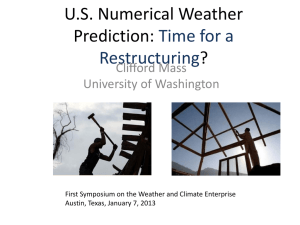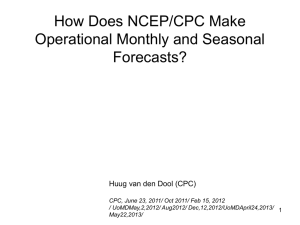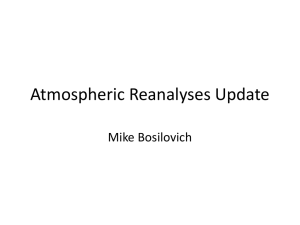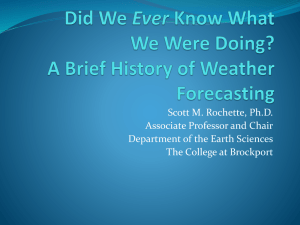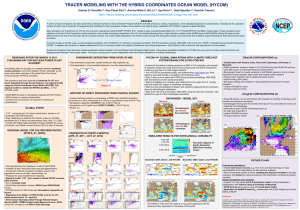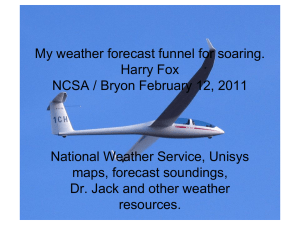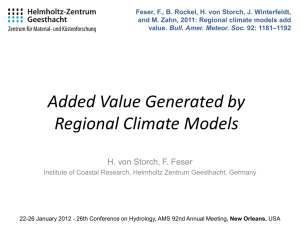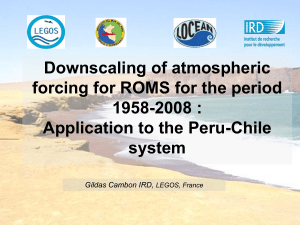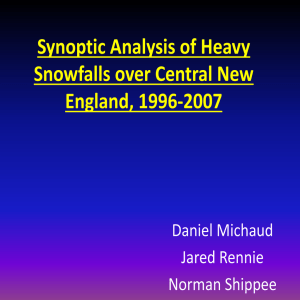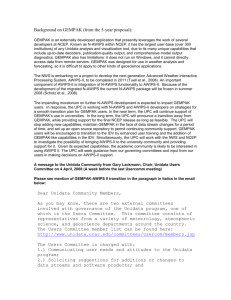His PowerPoint presentation is available for you viewing.
advertisement
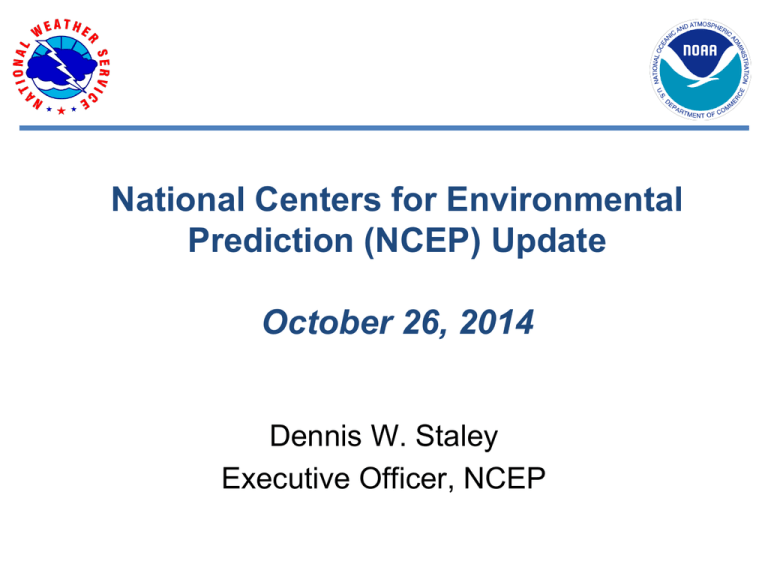
National Centers for Environmental Prediction (NCEP) Update October 26, 2014 Dennis W. Staley Executive Officer, NCEP Outline • Who We Are • Were We Have Been • What We Have Achieved • Where We are Going: Drivers for Change • NCEP’s Role in Impact-Based Decision Support Services • FY15 Key Activities • NCEP Labor/Management Success Stories • Summary 2 Who We Are: National Centers for Environmental Prediction 426 FTE 200 Contractors 40+ Visiting Scientists 6 NOAA Corps Officers $125M Budget NCEP Central Operations College Park, MD (Supercomputers in Reston & Orlando) Aviation Weather Center Kansas City, MO Climate Prediction Center College Park, MD Environmental Modeling Center College Park, MD Ocean Prediction Center College Park, MD Space Weather Prediction Center Boulder, CO Storm Prediction Center Norman, OK Mission Provide reliable, timely, and accurate analyses, guidance, forecasts, and warnings for the protection of life and 3property and the enhancement of the national economy National Hurricane Center Miami, FL Weather Prediction Center College Park, MD Vision Nation’s trusted source, first alert, and preferred partner for environmental prediction services Who We Are: What NCEP Delivers “Provision of Services from the Sun to the Sea” Solar Monitoring, Warnings and Forecasts Climate Seasonal Forecasts El Nino – La Nina Forecast Weather Forecasts to Day 7 Extreme Events (Hurricanes, Severe Weather, Snowstorms, Fire Weather) Aviation Forecasts and Warnings High Seas Forecasts and Warnings Model Development, Implementation and Applications for Global and Regional Weather, Climate, Oceans and now Space Weather International Partnerships in Ensemble Forecasts Data Assimilation including the Joint Center for Satellite Data Assimilation Super Computer, Workstation and Network Operations 4 4 Where We Have Been 5 What We Have Achieved Top Accomplishments 2009-2013 NCO • Transitioning to New Facility (NCWCP) with No Loss of Products • Transitioning to Weather and Climate Operational Supercomputer System With a New Operating System • Improving On-Time Delivery of Supercomputer Products: 99.99% SWPC • Implementing First Operational Space Wx Prediction Model: WSA-ENLIL OPC • Changing From Text Only Forecasts to Gridded and Text Forecasts for the Marine Offshore Forecasts CPC • Developing a National Multi-Model Ensemble (NMME) Capability to Advance the Skill of NOAA’s Seasonal Predictions EMC • Implementing New Models and Upgrades: CFSv2; Hybrid En-3DVAR; RTOFS; HWRF; RAP; HRRR; LDAS; Ensembles (GEFS, SREF, NAEFS) 6 What We Have Achieved Top Accomplishments 2009-2013 WPC • Developing Ensemble-Based Gridded Probabilistic Snow and Freezing Rain Forecasts--used by WFO Sterling (WRN Pilot Project) to Issue Experimental Winter Snowfall Probabilistic Products AWC • Strengthening Partnership with FAA by Placing DSS Meteorologists at FAA National Command Center in Warrenton, Va • Establishing Robust and Active Aviation Weather Testbed NHC • Leading in the Hurricane Forecast Improvement Program (HFIP) and Joint Hurricane Testbed (JHT) Activities Resulting to Improvements in Hurricane Track and Intensity Forecasts SPC • Establishing Routine Collaboration with National and Regional FEMA; FEMA Liaison at SPC in 2014 • Partnership Exercised Successfully in Historic 2011 Tornado Season 7 NHC Official Forecast Performance Atlantic Basin Track forecast improvements • Errors cut in half over past 15 yrs • 10-yr improvement - 48 hrs forecast of today is as accurate as our 24 hrs forecast in 2000 Intensity forecast improvements • Significant improvements since HFIP Program established (2009) • HFIP 5-Year Goal Achieved 8 Where We are Going: Drivers for Change • New NCEP Director • NWS Strategic Plan Focused on Building a “Weather-Ready Nation” and “Improved Decision Support Services” • New NWS HQ Reorganization and Budget Restructuring • Sandy Supplemental is Game Changer in All Aspects of the End-toEnd Forecast Process (i.e. Observations, Modeling, Computing, Forecast Services, etc) • External Reviews • UCAR Advisory Committee for NCEP 2013/2014 Report Weather Services for the Nation: Becoming Second to None Forecast for the Future: Assuring the Capacity of the NWS (NAPA Report, 2013) New NCEP Strategic Plan 9 NCEP Alignment with DOC/NOAA/NWS Priorities Weather-Ready Nation Embraced by NAPA: “We Can’t do it Alone” DOC Strategic Plan #3 – Environment 3.2 Improve preparedness, response, and recovery from weather and water events by building a Weather-Ready Nation #4 -- Data 4.3 Collaborate with the business community to provide more timely, accurate, and relevant data products and services for customers NOAA Shared Priorities #2 - Evolve the NWS a. Build a Weather-Ready Nation by holding ourselves accountable for the accuracy of our forecasts and ensuring people know how to react to that information b. Create a National Weather Service based on a fully integrated field structure that provides nationally consistent products and services, manages innovation, and accelerates research to operations across NOAA NWS Strategic Goals 1) Improve Weather ImpactBased Decision Support Services 2) Improve Water Forecasting Services 3) Enhance Climate Services and adapt to climate-related risks 4) Improve sector-relevant information in support of economic productivity 5) Enable environmental forecast services supporting healthy communities and ecosystems 6) Sustain a highly skilled, professional workforce 10 Sandy Supplemental • Provided $466M to NOAA to Address Sandy Mitigation ($87M to NWS) • Key Areas: – Observations – Computing Capacity – Model Upgrades – Dissemination: Ground Readiness – Storm Surge Enhancements ✓ A “Game Changer” for Enhancing the Entire Forecast Process ✓ Offers Opportunity to Accelerate Major Advancements to the Operational Computer and Model Infrastructure ✓ Monthly Tracking and Reporting Required – Training; Including Social Science – JPSS Gap Mitigation – Facilities Repairs 11 Setting the Stage for Change: 2012 NAS Reports and 2013 NAPA Report Strategic Tactical Develop a Framework to Guide Change, and begin a deliberate Pace of Change Embrace “Weather-Ready Nation” and six Strategic goals – but emphasize we can’t do it alone Energized Stakeholder Engagement/ External advice Restructured/ transparent budget follows function Energize private sector engagement/enhance secondary value chain (NWSHQ a good place to realign first) Centralized Change Management/IT Development Solidify NWSEO relationship Enhanced capacity for testing and demonstration – (O2R/R2O) - Training Improve Service Consistency Across the NWS - IDSS “Open Weather and Climate” support for Commercial and Research Sectors Improve innovation management/Find efficiencies in infrastructure NCEP is Key Player in Execution 12 12 UCAR Advisory Committee for NCEP: Major Messages • Revise/Update NCEP Strategic Plan • Take advantage of opportunities associated with move to the NCWCP; VSP Program • Workforce Management: Hire the Best and Brightest • “Second to None” Charge: Apply to NCEP Products, Services and Modeling • Use Science-Based “Trade-Space” Priority Setting for Production Suite Resources – Shrink # of Models • Adopt a Unified Coupled Modeling Framework • Strengthen Interactions with Research Community 13 New NCEP Strategic Plan: Timeline Strategic Planning Kickoff – June 2, 2014 Local Office Team Meetings – External Stakeholder Workshop – through July and August 2014 October 2014 Draft Plan Formulation – October through December 2014 Draft Plan delivered to NCEP DirectorEarly 2015 14 The Director’s DRAFT Vision for NCEP NCEP is the trusted source of weather, water, climate and space weather guidance, forecasts, warnings and analyses used to protect life and property, stimulate economic growth and improve the quality of every day life. NCEP employees are a valued national asset, using science, innovation, and collaboration to create and deliver accurate environmental products and services-----on time, every time, all the time spanning the Sun to the Sea…. 15 Strategic Areas for NCEP in the Next 5 Years • A major player in building and sustaining a Weather Ready Nation • • • • • and providing Impact-Based Decision Support Services Strategically expand science/service areas based on user requirements: • 3-4 weeks forecasts (closing the gap between weather and climate) • Extending lead time for high impact events • Incorporate a full earth system science approach • Strategically transition research into operations (R2O/O2R) Deliver (with partners) the WRN integrated field structure Deliver world class operational numerical guidance required to support the WRN Deliver timely, reliable, consistent and accurate products/services Deliver high capacity IT infrastructure support, high performance computing and technical management services 16 NCEP’s Role in Impact-Based Decision Support Services 17 IDSS Support at NCEP National Federal Partners Internal NOAA Sector Specific Support National Media International 18 Internal NOAA-NWS-NCEP NOC NHC SPC ROCs WPC AWC Serve key role to raise local situational awareness 19 Unique Internal NOAA Ecological Modeling FY15 Milestone: Issue marine forecasts for the Antarctic to support NOAA’s National Marine Fisheries Service in Antarctica. FEMA / DHS Briefings FEMA Liasons Daniel Porter Monthly or Regular Basis and Special Partner Briefings in Advance of Major Events Somer Erickson Matthew Green 21 Special Sector Support (National Aviation Met.) • Ensuring Weather Situational Awareness • Collaborating with CWSU/WFO/AWC • Adding Insight to Static NWS Products (e.g., Uncertainty) • Scheduled and On-Demand (Event-Driven) Briefings • Impact-Based Decision Support Services 22 National Media 23 International NCEP executes over half of NWS International travel NCEP Training Desks South America / Tropical Africa / Monsoon Scientific and Service Engagement Satellite Coordination Global Model Coordination Specialized Support Japanese Tsunami Haiti Earthquake 24 DSS Challenge: How to Better Integrate NWS Field Structure • • • • NCEP and WFOs have a responsibility to collaborate NCEP forecasts are improved by WFO interaction WFO’s forecasts are improved by NCEP interaction End result is a more consistent, accurate, and trusted NWS forecast and DSS message • Need common culture of collaboration – NCEP needs to earn WFO trust/respect – ‘MY’ forecast needs to becomes ‘OUR’ forecast • Need common analysis and verification • Need common tools (AWIPS II, Sit Aware tool) • Need clear roles and responsibilities 25 Opportunities (ROCs) NOC NHC SPC WPC AWC CPC OPC SWPC ROCs ROCs could help facilitate NCEP-WFO collaboration on a consistent DSS message -Monitor and anticipate issues -Proactively set up collaboration calls 26 * Opportunities (Probabilistic DSS) Risk of Event Risk Tolerance Take Action Action Cancel Flights Risk Tolerance 40% Chance of Heavy Snow 45% NWS worked with FAA and Industry to define impact thresholds Criteria for DCA Event Slight Modt High Prob >40% Prob >40% Prob > 40% 3-h Snow > 0.2” > 0.75” > 1.5” 24-h Snow > 1” > 2” >6” > 0.01” > 0.05” < 1 mi < ½ mi 3-h Fz Rain Visibility < 3 mi 27 Opportunities (Probabilistic DSS) Provide a reasonable best / worst-case scenario Most Likely Maximum Minimum (5”) (13”) (1”) DC DC DC Expect at least this much Official NWS Forecast Potential for this much Local Emergency Manager: “This is one of the most important new initiatives from NWS we have seen for Emergency Managers in years.” 28 Opportunities (Integrating Social Science) Storm Surge Convective Outlook Hazards Simplification 29 Rapid Refresh and HRRR NOAA hourly updated models 13km Rapid Refresh (RAP) (mesoscale) V2 in ops: 2/25/14 3km HRRR (storm-scale) RAP HRRR High-Resolution Rapid Refresh Scheduled NCEP Implementation Sept 2014 30 * HRRR Benefits • Increased resolution (3km) of basic fields like temperatures, winds, visibility, etc to resolve mesoscale features • Explicitly allows convection, allowing for storm-scale structure; shows skill at predicting storms with strong rotation, bow echoes, etc. • Provides hourly updates at high resolution • Out to 15 hours • Will be a key part of future NCEP hi-res ensemble * 31 High Impact Prediction Needs: Higher Resolution Models 40 km RUC 1998 (1.5x resolution) 20 km RUC 2002 (3x resolution) 13 km RUC/RAP 2005 (4.6x resolution) 3 km HRRR 2014 (20x resolution) High Impact Prediction Needs: Higher Resolution Models * 33 High Impact Prediction Needs: Higher Resolution Models Hurricane Arthur * 34 Observations Used High Impact Prediction Needs: Higher Resolution Models 13-km 6hr forecast HRRR 6hr forecast 07 June 2012 5 PM EDT Reality Aircraft must Navigate Around Thunderstorms 3-km HRRR Explicit Convection 6 hr forecast 13-km RAP Parameterized Convection 6 hr forecast Accurate Storm Structure No Storm Structure Accurate Estimate of Permeability No Estimate of Permeability 35 June 16 “Twin Tornado” Supercell in northeast Nebraska * 36 14z + 7hr 16z + 5hr 15z + 6hr 17z + 4hr Clear trend in hourly cycle for enhanced risk in 37 * northeast NE FY15 Key Activities • Upgrade WCOSS – 3X Compute Capacity • Award New WCOSS Contract • Develop Experimental Weeks 3-4 Temperature and Precipitation Outlook • Develop Experimental Week-2 Heat Watch Outlook Product • Operationalize National Multi-Model Ensemble (NMME) System • Expand SPC Watch Coverage from 20nm Offshore to 60nm Offshore • Enhance SPC Convective Outlooks for Days 1,2,3 – Add Two New Risk Categories 38 SPC Day 1, Day 2 and Day 3 Convective Outlooks • Added 2 new risk categories: - "Marginal" - "Enhanced“ • Implemented October 22 NEW OLD FY15 Key Activities • Develop Experimental Day 4-7 Winter Outlook Product • Develop Experimental 72-h Winter Weather Watch Recommender on an Internal Web Site for WFO Evaluation/Feedback • Expand Winter Weather Desk to 24X7 Coverage to increase collaboration and consistency with field offices • Implement Model Upgrades: GFS, GDAS, GEFS, HWRF • Develop Seasonal Severe Wx Outlook • Develop Whole Atmospheric Model for Space Wx • Implement Experiment Tropical Storm Surge Watch/Warning Product 40 FY15 Key Activities • Implement Experimental Aviation Probabilistic Convection Guidance Aimed to Improve Consistency • Implement Experimental Aviation Probabilistic Guidance for Cloud and Visibility • Begin Issuing Marine Forecasts for the Antarctic to Support NOAA's National Marine Fisheries Service in Antarctica • Finalize and Implement New NCEP Strategic Plan • Conduct Center Reviews through the UCAR External Review Team 41 NCEP Labor Management Success Stories • Ocean Synergy Team: Established in 2003 – To improve ocean forecasts through collaboration and increased operational effectiveness of the three ocean forecast offices (OPC, NHC, HFO) – Improve product quality and consistency across boundaries – Coordinate on future improvements – Increased efficiency for technical developments – Discussion Underway to Expand to AK • Timeliness Team: Improved Center Timeliness from Mid 70% in Early 2000’s to 98% Today • Joint Labor/Management Training • NCEP Strategic Plan 42 Summary • NCEP is aligned with DOC, NOAA and NWS Strategic Planning Goals • NCEP is a Critical Component to NWS Success & Underutilized Resource • NCEP is Committed to Maintaining a Strong Labor Management Relationship • NCEP Key Strategic Areas Over Next Five Years – – – – Leader in integrated field structure and DSS World class modeling center World leader in high performance computing Expand science/service areas (3-4 weeks forecasts; full ESS approach; National IDSS) 43 Thank You 44 Appendix 45 Summary of Employee Input 46 Sandy Supplemental Projects • • • • • • • • • • • • • • • • Operational Supercomputing Global & Ensemble Model Upgrades Global 4-D Hybrid Data Assimilation Tropical Cyclone Relocation in NAM Observing System Experiments HPC Software Management and Integration (Operational Model Implementation Support) Blends of Global Models GOES Data Assimilation and Product Development Cloud-Based Radiance Data Assimilation Atmospheric Motion Vectors Near-shore Wave Prediction System SLOSH & Gridded Winds Storm Surge Guidance Storm Surge Training Social Science & Science Infusion Training Decision Support Services Training • • • • • • • • • • • • • • • • Facilities – WFO Hardening Facilities – WFO Repair Facilities – NOAA Weather Radio Facilities Rain Gage O&M Automated Surface Observations Radiosondes (Upper Air) Caribbean Radar Observations Dual Pol NEXRAD Enhancements Multi-Radar, Multi-Sensor Systems (R2O) Aircraft Observations Buoys NWS Data Availability NOAA Weather Wire Service & NOAA Weather Radio Meteorological Assimilation Data Ingest System (MADIS) Ground Readiness Project Hurricane Forecast Improvement Project (R2O) 47 SCIENTIFIC CHALLENGE Short Range Weather Prediction Hurricane Track Forecasts (out to 5 days) Public Gridded Forecasts (out to 7 days) Mid-Range Forecasting Week 3-4 Temperature Outlooks (1 & 3 Months) ? Severe Weather Outlook (out to 8 days) Precipitation Outlooks (1 & 3 Months) Seasonal Drought Outlook (1 Month & Seasonal) Temp/Precip Outlooks (6 -10, 8 -14 days) DAYS Long Range Climate Prediction WEEK S MONTHS National Climate Assessment (Years and Decades) 48 YEARS DECADES CLIMATE PREDICTION CENTER (Current and Experimental Products) CURRENT PRODUCT Precipitation Probability (8-14 Day Outlook) Probability of Above Probability of Below 2015 EXPERIMENTAL PRODUCT Average Precipitation (3-4 Weeks Outlook) Probability of Above Probability of Below POTENTIAL FUTURE PRODUCTS Extreme Precipitation Potential High Risk of Extreme Precipitation 49

